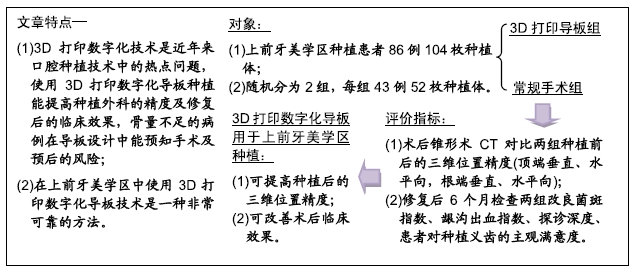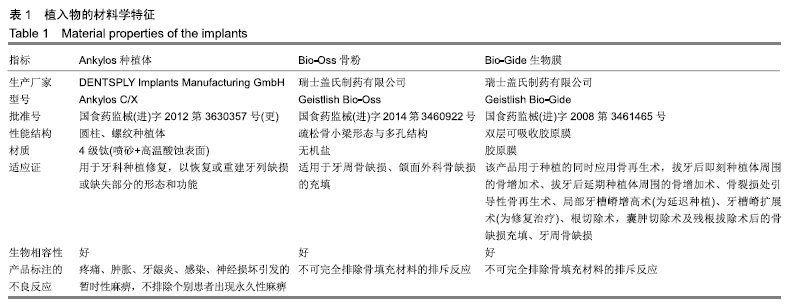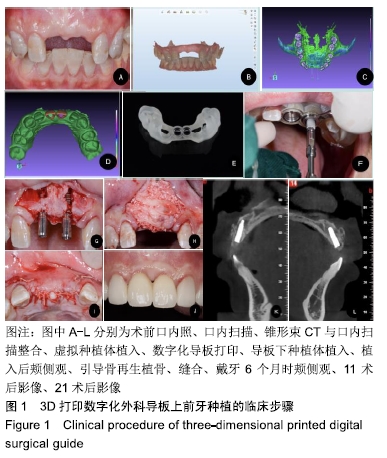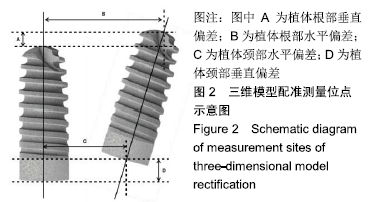[1] 袁治,陈一晖.数字化快速成型牙种植导板辅助修复上前牙种植:12个月随访[J].中国组织工程研究,2016,20(7):987-992.
[2] SUN HP, LIN J, HUANG SX. Clinical use of digital implant surgical guide and short implants in mandibular edentulous jaw with insufficient bone mass in the posterior areas-a case report. Clinical Oral Implants Research.2018;29:403.
[3] 柴金友,刘建彰,王兵,等.一种切削法制作的数字化种植手术导板加工精度评价[J].北京大学学报(医学版),2018,50(5):892-898.
[4] MOMBELLI A, VAN OOSTEN MA, SCHURCH E JR, et al. The microbiota associated with successful or failing osseointegrated titanium implants. Oral Microbiol Immunol. 1987;2(4):145-151.
[5] DAHIYA A, GARBACEA A, KATTADIYIL MT, et al. Digital technology for performing a nasopalatine and greater palatine nerve block with a modified implant surgical guide: A technique article. J Prosthet Dent. 2018;120(3):338-342.
[6] ARORA H, IVANOVSKI S. Clinical and aesthetic outcomes of immediately placed single-tooth implants with immediate vs. delayed restoration in the anterior maxilla: A retrospective cohort study. Clin Oral Implants Res. 2018;29(3):346-352.
[7] DURSUN E, LIN GH, TAHERI S, et al. A Comparison of Esthetic Features of Pre-existing Natural Tooth Versus Post-Implant Restoration in the Esthetic Zone: A Retrospective 12-month Follow-up. Int J Oral Maxillofac Implants. 2018;33(4):919-928.
[8] LADINO LG, ROSSELLI D. Use of extracted anterior teeth as provisional restorations and surgical guide for immediate multiple implant placement: A clinical case report. J Esthet Restor Dent. 2019; 31(3):209-212.
[9] VLAHOVIĆ Z, MIKIĆ M. 3D Printing Guide Implant Placement: A Case Report. Balk J Dent Med. 2017;21:65-68.
[10] WANG CW, BHASKAR V, DICKERMAN B, et al. Computer‐Guided Immediate Implant Placement and Predigitally Designed Immediate Provisionalization.Clinical Advances in Periodontics. 2018;8(1):39-44.
[11] FLÜGGE T, VAN DER MEER WJ, GONZALEZ BG, et al. The accuracy of different dental impression techniques for implant-supported dental prostheses: A systematic review and meta-analysis. Clin Oral Implants Res. 2018;29 Suppl 16:374-392.
[12] PASQUALINI M, ROSSI F, CARLO LD, et al. Rehabilitations of a single element with one-piece implants with electrowelded needles: A different approach. Dent Res J (Isfahan). 2018;15(6):447-452.
[13] SPIES BC, FATKULAJEW T, KOHAL RJ, et al. Contemporary Digital Restorative and Minimal-Invasive Preservative Surgical Techniques in the Esthetic Zone: A Case Report. Implant Dent. 2018;27(1):142-145.
[14] SONG IS, LEE MR, RYU JJ, et al. Reconstruction of a Severely Atrophied Alveolar Ridge by Computer-Aided Gingival Simulation and 3D-Printed Surgical Guide: A Case Report. Int J Oral Maxillofac Implants. 2018;33(3):e73-e76.
[15] GAKONYO J, MOHAMEDALI AJ, MUNGURE EK. Cone Beam Computed Tomography Assessment of the Buccal Bone Thickness in Anterior Maxillary Teeth: Relevance to Immediate Implant Placement. Int J Oral Maxillofac Implants. 2018;33(4):880-887.
[16] 郭磊,杨倞,王远勤.上颌后牙区数字化导板引导下倾斜种植精确性研究[J].口腔疾病防治,2017,25(7):435-438.
[17] 满毅.数字化技术在口腔种植修复中的应用[J].口腔医学, 2017, 37(7): 577-582.
[18] OZAN O, TURKYILMAZ I, ERSOY AE, et al. Clinical accuracy of 3 different types of computed tomography-derived stereolithographic surgical guides in implant placement. J Oral Maxillofac Surg. 2009; 67(2):394-401.
[19] ALZOUBI F, MASSOOMI N, NATTESTAD A. Bone Reduction to Facilitate Immediate Implant Placement and Loading Using CAD/CAM Surgical Guides for Patients With Terminal Dentition. J Oral Implantol. 2016;42(5):406-410.
[20] SCHERER MD, ROH HK. Radiopaque dental impression method for radiographic interpretation, digital alignment, and surgical guide fabrication for dental implant placement. J Prosthet Dent. 2015;113(4): 343-346.
[21] DADA K, PARIENTE L, DAAS M. Strategic extraction protocol: Use of an image-fusion stereolithographic guide for immediate implant placement. J Prosthet Dent. 2016;116(5):652-656.
[22] OZKOMUR A, MANFROI F. Multifunctional Guide for Implant Placement, Impressions, and an Occlusal Index for Fixed Complete Dentures. J Prosthodont. 2018;27(2):197-200.
[23] MEIJER HJA, SLAGTER KW, VISSINK A, et al. Buccal bone thickness at dental implants in the maxillary anterior region with large bony defects at time of immediate implant placement: A 1-year cohort study. Clin Implant Dent Relat Res. 2019;21(1):73-79.
[24] CALVO-GUIRADO JL, LÓPEZ-LÓPEZ PJ, PÉREZ-ALBACETE MARTÍNEZ C, et al. Peri-implant bone loss clinical and radiographic evaluation around rough neck and microthread implants: a 5-year study. Clin Oral Implants Res. 2018;29(6):635-643.
[25] HAPPE A, FEHMER V, HERKLOTZ I, et al. Possibilities and limitations of computer-assisted implant planning and guided surgery in the anterior region. Int J Comput Dent. 2018;21(2): 147-162.
[26] HONDA K, HIROTA M, IWAI T, et al. Orthognathic Surgery and Implant-Supported Bridge in a Class III Patient Injured in a Motor Vehicle Accident. J Craniofac Surg. 2018;29(3): e296-e298.
[27] ALSROUJI MS, AHMAD R, IBRAHIM N, et al. Blood Flow Alterations in the Anterior Maxillary Mucosa as Induced by Implant-Retained Overdenture. J Prosthodont. 2019;28(4): 373-378.
[28] KLINGE B, LUNDSTRÖM M, ROSÉN M, et al. Dental Implant Quality Register-A possible tool to further improve implant treatment and outcome. Clin Oral Implants Res. 2018;29 Suppl 18:145-151.
[29] PARK SJ, LEESUNGBOK R, CUI T, et al. Reliability of a CAD/CAM Surgical Guide for Implant Placement: An In Vitro Comparison of Surgeons' Experience Levels and Implant Sites. Int J Prosthodont. 2017;30(4):367-369.
[30] FOTOPOULOS I, PANAGIOTIDOU E, KAPAGIANNIDIS I, et al. Accuracy of computer-guided implant surgery in partially edentulous patients by using 3Shape software planning program.Clinical Oral Implants Research. 2018;29:386.
[31] D'HAESE J, ACKHURST J, WISMEIJER D, et al. Current state of the art of computer-guided implant surgery. Periodontol 2000. 2017;73(1): 121-133.
[32] MATTA RE, BERGAUER B, ADLER W, et al. The impact of the fabrication method on the three-dimensional accuracy of an implant surgery template. J Cranio-maxillofac Surg. 2017;45(6):804-808.
[33] 陈妍曲,唐敏,黄旋平,等.高精度三维整合牙颌模型个体化微种植体手术导板的计算机辅助设计与制作[J].中国组织工程研究, 2018,22(10): 1529-1533.
[34] 赵殿才,聂玉洁,欧阳舢,等.3D打印复合型种植导板在游离端牙缺失种植修复中的临床应用[J].中国组织工程研究,2018, 22(14): 2179-2184.
[35] OH JH, AN X, JEONG SM, et al. Digital Workflow for Computer-Guided Implant Surgery in Edentulous Patients: A Case Report. J Oral Maxillofac Surg. 2017;75(12):2541-2549.
[36] WHITLEY D 3RD, EIDSON RS, RUDEK I, et al. In-office fabrication of dental implant surgical guides using desktop stereolithographic printing and implant treatment planning software: A clinical report. J Prosthet Dent. 2017;118(3): 256-263.
[37] REBEEAH HA, YILMAZ B, SEIDT JD, et al. Comparison of 3D displacements of screw-retained zirconia implant crowns into implants with different internal connections with respect to screw tightening. J Prosthet Dent. 2018;119(1):132-137.
[38] DRAGO C. Ratios of Cantilever Lengths and Anterior-Posterior Spreads of Definitive Hybrid Full-Arch, Screw-Retained Prostheses: Results of a Clinical Study. J Prosthodont. 2018;27(5):402-408.
[39] BELL CK, SAHL EF, KIM YJ, et al. Accuracy of Implants Placed with Surgical Guides: Thermoplastic Versus 3D Printed. Int J Periodontics Restorative Dent. 2018;38(1):113-119.
|








